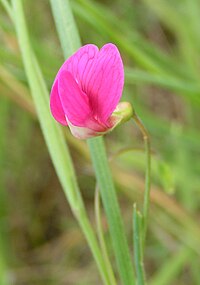
Photo from wikipedia
Lathyrus linifolius L. (Reichard) Bässler (Fabiaceae, bitter vetch) is a nitrogen (N) fixing species. A coloniser of low nutrient (N) soils, it supports biodiversity such as key moth and butterfly… Click to show full abstract
Lathyrus linifolius L. (Reichard) Bässler (Fabiaceae, bitter vetch) is a nitrogen (N) fixing species. A coloniser of low nutrient (N) soils, it supports biodiversity such as key moth and butterfly species, and its roots are known for their organoleptic and claimed therapeutic properties. Thus, the species has high potential for restoration, conservation, novel cropping and as a model species. The last because of its genetic synteny with important pulse crops. However, regeneration and functional attributes of L. linifolius remain to be characterised. Seeds of L. linifolius were characterised using physical, colorimetric and chemical data. Ultrastructural and functional characterisation of the N-fixing root nodules included immunolabelling with nifH protein antibodies (recognising the N-fixing enzyme, nitrogenase). Endosymbiotic bacteria were isolated from root nodules and characterised phylogenetically using 16S rRNA, nodA and nodD gene sequences. L. linifolius yielded heteromorphic seed of distinct colour classes: green and brown. Seed morphotypes had similar C:N ratios and were equally germinable (ca. 90%) after scarification at differing optimal temperatures (16 and 20 °C). Brown seeds were larger and comprised a larger proportion of the seed batch (69%). L. linifolius root nodules appeared indeterminate in structure, effective (capable of fixing atmospheric N) and having strains very similar to Rhizobium leguminosarum biovar viciae. The findings and rhizobial isolates have potential application for ecological restoration and horticulture using native seeds. Also, the data and rhizobial resources have potential applications in comparative and functional studies with related and socio-economically important crops such as Pisum, Lens and Vicia.
Journal Title: Plant biology
Year Published: 2019
Link to full text (if available)
Share on Social Media: Sign Up to like & get
recommendations!